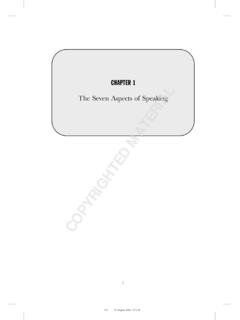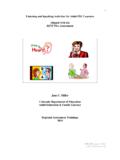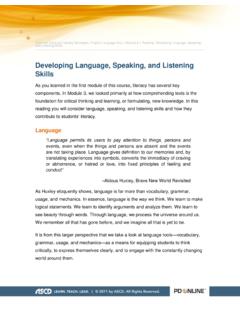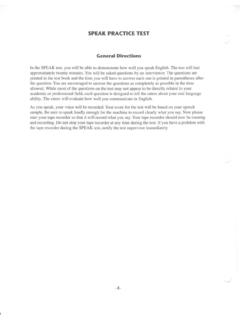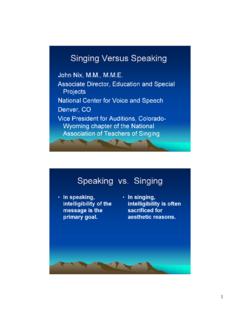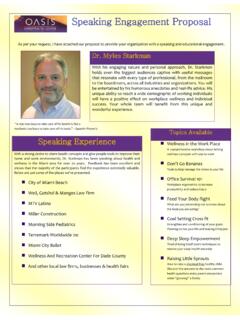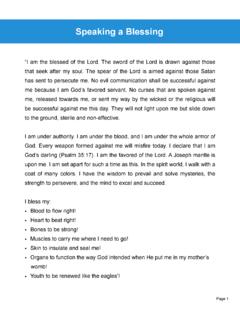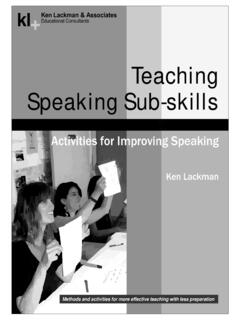Transcription of SPEAKING WITH CONFIDENCE
1 The University of Nevada, Reno is an Equal Opportunity/ Affirmative Action employer and does not discriminate on the basis of race, color, religion, sex, age, creed, national origin, veteran status, physical or mental disability, or sexual orientation in any program or activity it conducts. The University of Nevada employs only United States citizens and aliens lawfully authorized to work in the United States. COOPERATIVE EXTENSION Bringing the University to You Curriculum Materials 00-08 SPEAKING with CONFIDENCE A teaching guide to improve public SPEAKING in youth. Steven R. Lewis, Extension Educator SPEAKING with CONFIDENCE 1 COURSE OUTLINE Session Subject 1 Describe the kind or type of speaker you want to be 2 What makes a good speech? 3 Butterflies in formation (controlling nervousness) 4 Demonstrations using audio-visuals 5 Debate 6 Body language, posture, and vocal variety 7 Phone conversations 8 Interviews 9 The Grand Finale (each give 5 minute speech)* * SPEAKING with CONFIDENCE consists of 9 one-hour sessions.
2 The final session may need to be expanded to accommodate all students giving 5-minute speeches. The University of Nevada, Reno is an Equal Opportunity/Affirmative Action employer and does not discriminate on the basis of race, color, religion, sex, age, creed, national origin, veteran status, physical or mental disability, and in accordance with University policy, sexual orientation, in any program or activity it operates. The University of Nevada employs only United States citizens and aliens lawfully authorized to work in the United States. SPEAKING with CONFIDENCE 2 GENERAL INFORMATION Learner Objectives Practice public SPEAKING each session Write and review personal public SPEAKING goals each session Gain CONFIDENCE in public SPEAKING skills Learner Guidelines (ground rules) 9 Stand when SPEAKING 9 Be positive about themselves and others 9 Listen while others are SPEAKING 9 Smile a lot Items Covered Each Session (1 Hour) Opening (first 5 minutes) Pledge of Allegiance 4-H Pledge Self-introductions if guest presenter is on the program Session subject (50 minutes) Closing Work on Journal (last 5 minutes) Information to Give to Guest Presenters Subject to cover (may use this teaching guide) Learner objectives Encourage learner participation and avoid excessive lecture!
3 Number of students in course Time limit of fifty minutes, leaving five minutes to open and five minutes to close. Date, time and place of class Places to Look for Guest Presenters Toastmaster Club Members Radio Station Employees School Teachers Lawyers Public Relations Experts Telephone Company Personnel Public Officials 4-H Leaders and Alumni Professional Training and Development Facilitators SPEAKING with CONFIDENCE 3 HOW TO USE THIS TEACHING GUIDE This curriculum guide can be used with various age groups. It seems to work best for the 11-14 year olds. Younger youth may find some of the exercises too challenging. Older youth seem to enjoy the curriculum when used with their same age group. The curriculum consists of 9 one-hour sessions. Each session is designed to address a different aspect of public SPEAKING .
4 It is recommended that you teach Session 1 and 2 first. There is no required sequence for the remaining topics. The teacher or leader may choose to teach all nine in the order in which they appear in the guide or concentrate more heavily on a few particular sessions depending on the needs and interests of the students. The Session Outline gives a snap shot of the entire session. The Objective states what the students will accomplish and the Materials section suggests items the teacher will need to help teach that session. Each session should begin and end with the Main Point. The main point should also be repeated numerous times throughout the session to reinforce its significance. The Opening question and warm up exercise is designed to start the session and get students interacting with one another.
5 This time may also provide a good opportunity for students to introduce themselves if a guest presenter is attending. Worksheets are teaching tools to help students remember key points. They can be found on the last page of each session. Each student should receive a worksheet copy. The teacher goes over the information as the students fill in the answers in the blank spaces. Answers are underlined and in italics in the guide. The Journal page provides a means for students to document progress, reflect on the session and determine areas that need improvement. The journal and other materials are located in the back of this guide as Tools . SPEAKING with CONFIDENCE 4 SESSION 1 Describe the kind or type of speaker you want to be Session Outline 9 State the main point 9 Describe what SPEAKING with CONFIDENCE means to you (warm-up exercise) 9 Review course outline 9 Review learner objectives and guidelines (worksheet) 9 Illustrate the speaker you will be 9 Explain your picture to the group 9 Restate the main point 9 Work on journal Objective: For students to articulate the goal(s) they want to accomplish in this program.
6 Materials: 3 X 5 cards, flipchart paper, colored markers, pencils, discarded magazines ( with good pictures), tape and scissors. State the Main Point - You can become the speaker you want to be if you describe it clearly and visualize in your mind that image. Opening question and warm-up exercise Each student is given a 3 X 5 card to write down a few thoughts about what SPEAKING with CONFIDENCE means. Each is then asked to stand, give their whole name, the school they attend, grade, and describe what SPEAKING with CONFIDENCE means to them. If there are exceptionally shy youth in the class you might break the class into small groups for this exercise. Review course outline Briefly go through the topics that will be covered in the course (page 1).
7 You might also inform the students of the dates for each topic and mention guest presenters that have been invited to participate. Ask for questions. Review learner objectives and guidelines Make copies of session 1 worksheet (page 6) and hand out to the students. Explain that all students will follow the guidelines. You may want to enlarge these guidelines and post them up each session. As you go through the guidelines have the student fill in the blanks on the worksheet. Read the first when SPEAKING . Ask the students why do you think that ground rule is important? Read the positive about yourself and others. Again ask why is that important? SPEAKING with CONFIDENCE 5 SESSION 1 Listen while others are SPEAKING .
8 Smile a lot. Next, review the learner objectives and mention that every student will accomplish these objectives. To practice public SPEAKING each session. To write and review personal public SPEAKING goals each session and to gain CONFIDENCE in public SPEAKING skills. Finally ask, are there any questions about these objectives and guidelines? Illustrate the speaker you will be Provide newsprint (flipchart paper), colored markers, discarded magazines, tape and scissors for each student to illustrate and/or creatively represent the speaker she/he will be by the end of the course. This could be a picture of someone they admire as a speaker, a place they see themselves SPEAKING , a reaction they would like to get from an audience, etc.
9 They are not allowed to use any words. This exercise is intended to help the student visualize their goal. After the images have been created have the students describe it using words on the back of the newsprint. Explain your picture to the group One student at a time will stand before the class with their picture and have the class try to interpret the meaning. After a short time, the student will explain what they were portraying in the picture by reading the description on the back. They are encouraged to hang this picture in their room or somewhere they will see it daily so they will think about it often. The Experimental Learning Model (Tool A) may be found in the back of this guide. If followed, the model should enhance the learning experience of the students in all the sessions.
10 Test the affect of the model by using this picture creation experience. Restate the Main Point - can become the speaker you want to be if you describe it clearly and visualize in your mind that image. Work on journal The journal exercise is intended to create a habit of goal setting. At the end of each session, the students are allowed 5 minutes to rewrite their goal, evaluate their strengths and weaknesses, and establish a step or two to improve. A good beginning goal statement would be their description of their picture. Each session thereafter, the goal statement may change and become more clear and specific. The journal page may be found in the back of this guide (Tool B). SPEAKING with CONFIDENCE 6 SESSION 1 WORKSHEET SPEAKING with CONFIDENCE Guidelines when SPEAKING .


